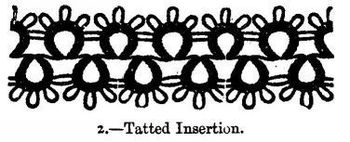
Picot
Encyclopedia

Crochet
Crochet is a process of creating fabric from yarn, thread, or other material strands using a crochet hook. The word is derived from the French word "crochet", meaning hook. Hooks can be made of materials such as metals, woods or plastic and are commercially manufactured as well as produced by...
ed, knitted
Knitting
Knitting is a method by which thread or yarn may be turned into cloth or other fine crafts. Knitted fabric consists of consecutive rows of loops, called stitches. As each row progresses, a new loop is pulled through an existing loop. The active stitches are held on a needle until another loop can...
or tatted
Tatting
Tatting is a technique for handcrafting a particularly durable lace constructed by a series of knots and loops. Tatting can be used to make lace edging as well as doilies, collars, and other decorative pieces. The lace is formed by a pattern of rings and chains formed from a series of cow hitch,...
material. These loops vary in size, according to their intended function and to their creator's artistic intention.
The word picot is pronounced [pē' kō]. It is a diminutive derived from the French verb piquer, meaning 'to prick'.
Tatting Method for Creating a Picot
To create a picot in tatting, the first half of a double stitch is made. However, instead of pulling that half-stitch taut against the stitch before it, the half-stitch is pinched against the foundation thread and held some distance from the stitch before it. The distance at which the half-stitch is held indicates the final size of the picot. The second half of the stitch is formed, and this stitch is slid down the foundation thread and into place next to the stitch before it. The resulting picot is then anchored between two double stitches. It is also possible to anchor the picot between the two halves of a full double stitch. See Carrie Carlson's clear instructions for picot stitching.Previous and Current Uses of Picots
Where picots formerly were used largely for ornament, they are now used functionally as well. In tatting, the picot is the site of the join between two rings, chains, or other pieces of work. This means that rather than creating some volume of independently-tatted rings or chains and then sewing or tying them together, an integral system of picots can be used to join these rings and chains as the work progresses.In older tatting and crocheting patterns, picots were sometimes specified as purls, purl stitches, or pearl stitches. These specifications are not to be confused with the reverse stitch known as a purl in knitting
Knitting
Knitting is a method by which thread or yarn may be turned into cloth or other fine crafts. Knitted fabric consists of consecutive rows of loops, called stitches. As each row progresses, a new loop is pulled through an existing loop. The active stitches are held on a needle until another loop can...
.

